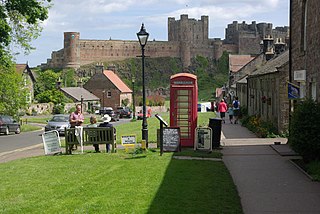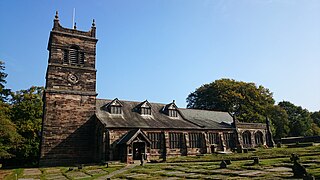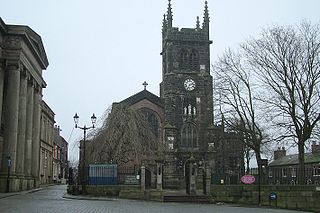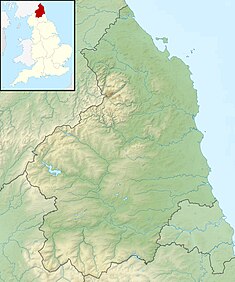History and description
Grace Darling's rescue, with her father, of nine survivors from the SS Forfarshire made her a national heroine. [2] Darling received the Gold Medal for Bravery from the Royal Humane Society, the Silver Medal for Gallantry from the precursor of the Royal National Lifeboat Institution, and a tribute fund included a contribution of £50 from Queen Victoria. Her death from tuberculosis four years later was an occasion of national mourning. [2] Buried in the churchyard of St Aidan's, she was additionally commemorated by a large funerary monument to the north of her grave, [1] designed by Anthony Salvin. Salvin's choice of Portland stone for the memorial was unfortunate, it weathered badly and by 1885 complete reconstruction was required. The original effigy of Darling was moved into the church and a replacement, carved from stone donated by William Armstrong, 1st Baron Armstrong of Bamburgh Castle, was designed by C. R. Smith. [3] Further damage was caused by a storm in 1895, and the canopy was replaced to a design by W. S. Hicks. In 2013, the 175th anniversary of the rescue was commemorated with a service. [4]
Sir Nickolaus Pevsner and Ian Richmond, in the Northumbrian edition of the Buildings of England describe the monument as a "Gothic shrine". The style is Decorated Gothic. [6] The recumbent effigy of Darling lies under a three-arched canopy with "metal colonettes" and topped by finials. [6] The monument was given a Grade II* listing designation in 1969. [7]

Bamburgh is a village and civil parish on the coast of Northumberland, England. It had a population of 454 in 2001, decreasing to 414 at the 2011 census.

Grace Horsley Darling was an English lighthouse keeper's daughter. Her participation in the rescue of survivors from the shipwrecked Forfarshire in 1838 brought her national fame. The paddlesteamer ran aground on the Farne Islands off the coast of Northumberland in northeast England; nine members of the crew were saved.

The Farne Islands are a group of islands off the coast of Northumberland, England. The group has between 15 and 20 islands depending on the level of the tide. They form an archipelago, divided into the Inner Group and the Outer Group. The main islands in the Inner Group are Inner Farne, Knoxes Reef, the East and West Wideopens, and the Megstone; the main islands in the Outer Group are Staple Island, Brownsman, North and South Wamses, Big Harcar, and Longstone. The two groups are separated by Staple Sound. The highest point, on Inner Farne, is 62 feet (19 m) above mean sea level.

Cragside is a Victorian Tudor Revival country house near the town of Rothbury in Northumberland, England. It was the home of William Armstrong, 1st Baron Armstrong, founder of the Armstrong Whitworth armaments firm. An industrial magnate, scientist, philanthropist and inventor of the hydraulic crane and the Armstrong gun, Armstrong also displayed his inventiveness in the domestic sphere, making Cragside the first house in the world to be lit using hydroelectric power. The estate was technologically advanced; the architect of the house, Richard Norman Shaw, wrote that it was equipped with "wonderful hydraulic machines that do all sorts of things". In the grounds, Armstrong built dams and lakes to power a sawmill, a water-powered laundry, early versions of a dishwasher and a dumb waiter, a hydraulic lift and a hydroelectric rotisserie. In 1887, Armstrong was raised to the peerage, the first engineer or scientist to be ennobled, and became Baron Armstrong of Cragside.

Hartburn is a village in Northumberland, in England. It is situated about 6 miles (10 km) to the west of Morpeth. The population at the 2011 census was 194.
This timeline summarises significant events in the history of Northumbria and Northumberland.

Forfarshire was a paddle steamer with brigantine rigging, built in Dundee in 1834, and which struck and later foundered on one of the Farne Islands on 7 September 1838, giving rise to the rescue for which Grace Darling is famed.

Little Wittenham is a village and civil parish on the south bank of the River Thames, northeast of Didcot in South Oxfordshire. In 1974 it was transferred from Berkshire to the county of Oxfordshire and from Wallingford Rural District to the district of South Oxfordshire.

A church monument is an architectural or sculptural memorial to a deceased person or persons, located within a Christian church. It can take various forms ranging from a simple commemorative plaque or mural tablet affixed to a wall, to a large and elaborate structure, on the ground or as a mural monument, which may include an effigy of the deceased person and other figures of familial, heraldic or symbolic nature. It is usually placed immediately above or close to the actual burial vault or grave, although very occasionally the tomb is constructed within it. Sometimes the monument is a cenotaph, commemorating a person buried at another location.

St Mary's Church is an Anglican parish church in the village of Newbold Astbury, Cheshire, England. It is recorded in the National Heritage List for England as a designated Grade I listed building, and its architecture has been praised by a number of writers.

St Mary's Church is an Anglican church at the end of a lane to the south of the village of Nether Alderley, Cheshire, England. It dates from the 14th century, with later additions and a major restoration in the late-19th century. The church is recorded in the National Heritage List for England as a designated Grade I listed building.

St Lawrence's Church, Over Peover is in the civil parish of Peover Superior. Close to Peover Hall and farm. It lies some 3 miles (5 km) south of the town of Knutsford. The church is recorded in the National Heritage List for England as a designated Grade I listed building. The church is an active Anglican parish church in the diocese of Chester, the archdeaconry of Macclesfield and the deanery of Knutsford. Its benefice is combined with that of St Oswald, Lower or Nether Peover. It is noted for its old chapels and for the monuments to the Mainwaring family.

St Mary's Church lies between the village of Rostherne and Rostherne Mere in Cheshire, England. The church is recorded in the National Heritage List for England as a designated Grade I listed building. It is an active Anglican parish church in the diocese of Chester, the archdeaconry of Macclesfield and the deanery of Knutsford. Its benefice is united with that of Holy Trinity, Bollington.

St Michael and All Angels Church overlooks Market Place in the town of Macclesfield, Cheshire, England. It is an active Anglican parish church in the diocese of Chester, the archdeaconry of Macclesfield and the deanery of Macclesfield. It forms a team parish with three other Macclesfield churches: All Saints, St Peter's and St Barnabas'. The church is recorded in the National Heritage List for England as a designated Grade II* listed building.

St Peter's Church is the parish church of the village of Petersham in the London Borough of Richmond upon Thames. It is part of the Diocese of Southwark in the Church of England. The main body of the church building dates from the 16th century, although parts of the chancel date from the 13th century, and evidence in Domesday Book suggests that there may have been a church on the site in Saxon times. Nikolaus Pevsner and Bridget Cherry describe it as a "church of uncommon charm... [whose] interior is well preserved in its pre-Victorian state". The church, which is Grade II* listed, includes Georgian box pews, a two-decker pulpit made in 1796, and a display of the royal arms of the House of Hanover, installed in 1810. Its classical organ was installed at the south end in late 2009 by the Swiss builders Manufacture d'Orgues St Martin of Neuchâtel, and a separate parish room was added in 2018. Many notable people are buried in the churchyard, which includes some Grade II-listed tombs.

St John the Baptist's Church is a redundant Anglican church in the village of Stanwick St John, North Yorkshire, England. It is recorded in the National Heritage List for England as a designated Grade I listed building, and is under the care of the Churches Conservation Trust. The site of the church is recognised as a Scheduled Monument, and it stands within the earthworks of Stanwick Camp, a settlement originating in the early Iron Age.

St Aidan's Church is a Grade I listed Church of England building in the Diocese of Newcastle.

The Trafford Mausoleum, is a memorial in Wroxham, Norfolk, England. Commissioned after the death of Sigismund Trafford Southwell in 1827, the mausoleum was designed by Anthony Salvin in Gothic Revival style. It is a Grade II listed structure.

Mamhead House, Mamhead, Devon, is a country house dating from 1827. Its origins are older but the present building was constructed for Robert William Newman, an Exeter merchant, in 1827–1833 by Anthony Salvin. The house is Grade I listed as Dawlish College, its function at the time of listing. The parkland is listed at Grade II*.



















